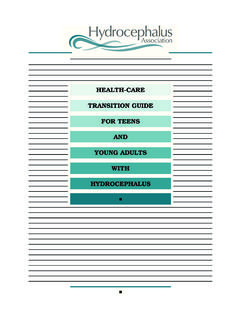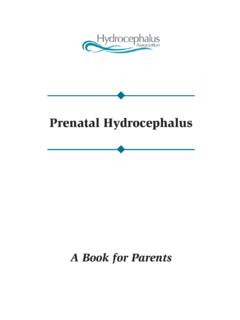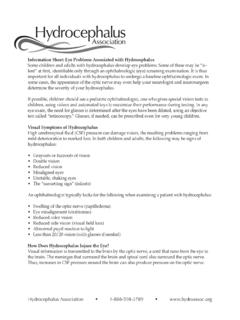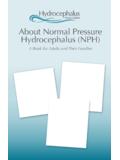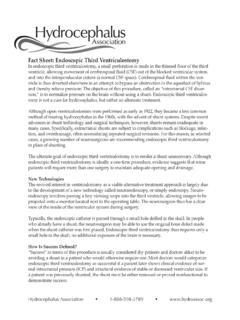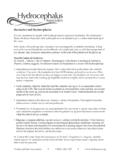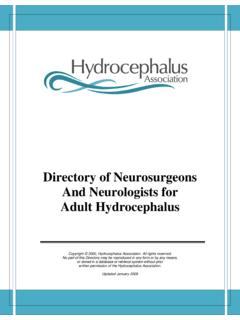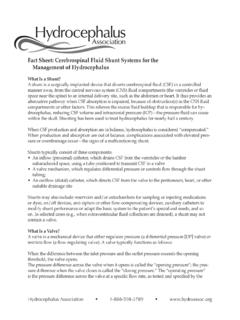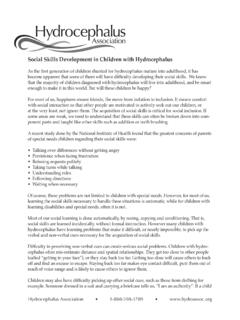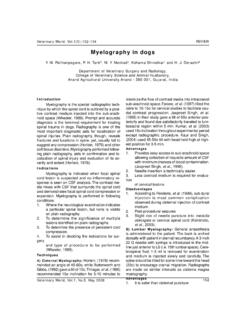Transcription of Hydrocephalus Diagnosed in Young and Middle …
1 Hydrocephalus Diagnosed inYoung and Middle -Aged AdultsA Book for Adults and Their FamiliesHydrocephalus Diagnosed in Young and Middle -Aged Adults A Book for Adults and Their Families was written for adults, their fami-lies and friends with the intention of providing information about the diagnosis and treatment of Hydrocephalus Diagnosed in adulthood. It is a companion piece to our booklet About Hydrocephalus A Book for Parents, the most widely distributed resource on infant and childhood Hydrocephalus in the United States. It is our belief that families and individuals dealing with the complex issue of Hydrocephalus Diagnosed in Young and Middle -aged adults must become educated about the condition in order to make informed deci-sions regarding treatment and care.
2 While each case differs, the informa-tion presented in this booklet is intended to give a general overview of the condition without making judgments or recommendations for indi-vidual associationsan francisco, californiasecond edition, january 2003 Editor: Rachel FudgeIllustrations: Lynne Larson 2003 Medical Consultants: Harold L. Rekate, Barrow Neurological Institute, Phoenix, AZ Michael A. Williams, Johns Hopkins Hospital, Baltimore, MD Special thanks to our medical reviewers:Rick Abbott, ; Alexa Canady, ; and Joseph Piatt, The following references were consulted in the writing of this booklet:Drs.
3 J. A. Cowan, D. Rigamonti and M. A. Williams: Clinically Distinct Syn-drome of Hydrocephalus in Young and Middle -Aged Adults, presented at the 3rd International Hydrocephalus Workshop, Kos, Greece, May 2001. Drs. G. P. Prigatano and H. L. Rekate: Long-Standing Overt Ventriculomegaly of the Adult: Neuropsychological Considerations, presented at the 6th Na-tional Conference on Hydrocephalus , Phoenix, AZ, May T. Fukuhara and M. Luciano: Clinical Features of Late-Onset Idiopathic Aque-ductal Stenosis, Surgical Neurology 2001; 55: 132 N. Buxton, D. Macarthur, M. Vloeberghs, J. Punt, I. Robertson: Neuroen-doscopic Third Ventriculostomy for Hydrocephalus in Adults: Report of a Single Unit s Experience with 63 Cases, Surgical Neurology 2001; 55: 74 of this booklet was made possible by a generous grant from the George H.
4 Sandy Foundation. 2003 Hydrocephalus Association, San Francisco, CaliforniaAll rights reserved. No part of this booklet may be used or reproduced in any form or by any means, or stored in a database or retrieval system, without prior written permission of the Hydrocephalus Association. Making copies of this booklet is against the law. Ad-ditional copies of this booklet may be obtained for a small fee from the Hydrocephalus Diagnosed in Young and Middle -Aged AdultsIntroductionFor many years, people with Hydrocephalus , their families and their doctors have worked unceasingly to increase public awareness of Hydrocephalus , its causes and its treatment. In the past half-century, great advances have been made in the diagnosis and treatment of hydro-cephalus, especially as it occurs in infants.
5 Normal pressure hydrocepha-lus (NPH), which occurs primarily in the elderly, is now receiving a great deal of media and medical attention, leading to more efficient and timely diagnosis and treatment. Hydrocephalus is now regularly de-tected in utero, before the baby is born. New treatment protocols, in-cluding advances in shunt and endoscopic technology, make it more likely than ever that people with Hydrocephalus whether Diagnosed in infancy or adulthood will live full, rich these advances over the past 50 years, there is still much to be learned about Hydrocephalus and the subtle forms it can take. Even now, Hydrocephalus is most commonly understood to occur in infants or the elderly at the extremes of life.
6 But in actuality, Hydrocephalus can occur at any time in life, and as a result of a variety of causes. And now doctors are beginning to identify and describe a distinct form of Hydrocephalus that arises in Young and Middle -aged different from Hydrocephalus Diagnosed in infancy and early childhood, or adult-onset normal pressure Hydrocephalus found in older adults (typically age 60 and older), Hydrocephalus in Young and Middle -aged adults is a unique and often confusing condition. Though it has only recently begun to receive formal attention from the medical com-munity, Hydrocephalus in this age group presents a host of challenges and opportunities for patients and medical professionals alike.
7 The chal-lenge goes far beyond routine or specialized medical care, encompassing psychosocial, emotional and occupational issues, all of which will be discussed in this Note on TerminologyMedical professionals are only just beginning to identify and describe the distinct syndrome of Hydrocephalus in adults. As yet, there is no universally agreed-upon term, such as normal pressure Hydrocephalus , to describe this population. We have chosen to use the term coined by Michael A. Williams, : the syndrome of Hydrocephalus in Young and Middle -aged adults (SHYMA). Other terms used to describe this and similar populations are late-onset idiopathic aqueductal stenosis, longstanding overt ventriculomegaly of the adult, and late-onset aque-ductal This BookletSome of the information in this booklet is adapted or reprinted from About Hydrocephalus A Book for Families and from other materials published by the Hydrocephalus Association.
8 We begin with a detailed description of Hydrocephalus in general, including its causes. Chapter 2 discusses symptoms and diagnosis, and Chapter 3 provides information about treatment of Hydrocephalus . Social and emotional issues resulting from SHYMA are outlined in Chapter 4. At the very end is a detailed list of further resources to is our first attempt to provide a detailed overview of SHYMA. Because this condition is only just beginning to be understood and identified, we realize that we all have much to learn. A revised edition will almost certainly be published within the next few years, as SHYMA becomes better understood. We welcome your ~ About HydrocephalusAnatomy and PhysiologyThe Brain, Spinal Cord and Their Protective CoveringsThe brain and spinal cord form the central nervous system.
9 These vital structures are surrounded and protected by the bones of the skull and the vertebral column. The bones of the skull are often referred to as the cranium. The places where the bones meet and grow are called sutures. The vertebral column, which encases the entire spinal cord, is composed of bones called vertebrae. The spinal column begins at the base of the skull and extends all the way to the tail brain s major components are the cerebrum, the cerebellum and the brain stem. The cerebrum is the central processing area for the body s incoming and outgoing messages. It is also the area responsible for speech, thought and memory. The cerebellum primarily helps coor-dinate our body movements.
10 The brain stem controls basic functions like heart rate, breathing and blood pressure. The spinal cord extends from the brain stem, through a very large opening (the foramen mag-num) in the base of the skull, and down the spine. At the level of each vertebra in the spine, nerve fibers arise from the spinal cord and emerge through openings between the vertebrae. These are the spinal nerves, which carry messages to and from various regions of our between the brain and skull are three protective coverings. These are the membranes (meninges), which completely surround the brain and spinal cord. An important fluid the cerebrospinal fluid (CSF) flows in a space between these membranes called the subarach-noid space.
